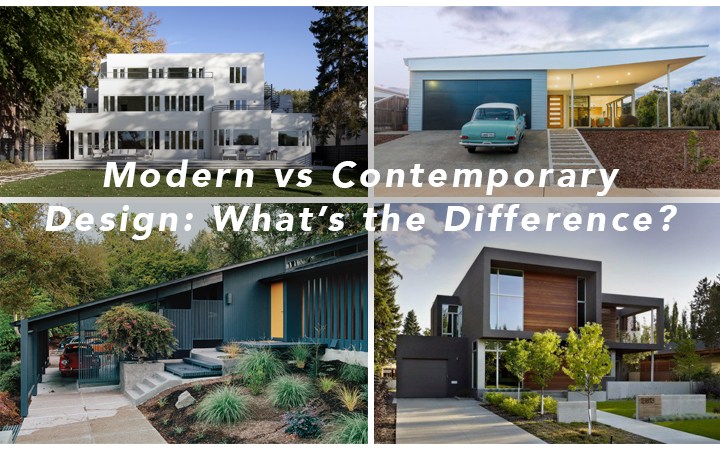MODERN VS CONTEMPORARY ARCHITECTURE: WHAT’S THE DIFFERENCE?
Contemporary vs Modern Architecture: What’s the Difference?
Contemporary and modern architecture are often used interchangeably when they couldn’t be more different. Discover what differentiates contemporary from modern architecture and find what’s the best option for you.
Have you been in the real estate market lately? If so, you’ve probably spent a lot of time looking around at descriptions of various beautiful houses.
On your journey across the land of real estate advertisement, you probably heard the terms “modern” and “contemporary” a lot.
And while you may have noticed that a lot of real estate agents treat the word as though they mean the same thing, they’re actually very different.
Are you confused about what the difference between contemporary architecture and modern architecture is? Read on to learn more about these two very different styles and the sort of look they break to a home.
The Basic Breakdown
To put it simply, modern architecture typically points to a type of style built between the early 1900s and the 1950s. It’s a very distinct, defined style and it doesn’t change.
So while you might think of “modern” and see images of houses built today, that’s actually not what it means in terms of architecture.
The contemporary design essentially means the style of today. It’s not something that can be pinpointed exactly, because styles and fashions and trends change quite quickly.
So, modern refers to a specific time period in American history and contemporary refers to the ever-changing trends in house design of today.
Modern Architecture
Now you have a better understanding of the basics, let’s break it down a little more for you.
The modern design came after a long period of highly decorated and fancy home design that held high favor at the end of the 19th century. At the time, eclecticism, Victorian, and Edwardian style were the lay of the land and architects felt the need to go against these traditions.
Modernists created homes that didn’t have that ornate flare that homes of that time were so used to. Instead, the homes had open floor plans, asymmetry, and huge panels of windows or glass walls.
They wanted to create a simple home that was also highly functional. They left out anything unnecessary.
At the time that modernism was created, technology was starting to take hold. More and more people were starting to move away from their roots and into fast-paced environments. This left little room for creativity, spirituality, and emotional connection.
Modernists wanted to allow the people who lived in their homes to feel closer and more connected to nature.
And because of this, they built homes to get rid of the boundaries between inside and outside. They wanted the outside of the home to compliment the environment around it.
Today’s Modernism
In today’s world, you might look at a home designed to look modern and consider it to be cold. Those stark lines and minimalism might seem off-putting at first, but when you step inside you might be surprised at just how warm it all is.
This is probably because of the dark, rich woods and marble that home builders used to create their homes, and all the warm colors that were popular at the time.
Mid-Century Modern
You’ve probably also heard the term mid-century modern thrown around. This is actually a variant of modernism that uses a lot of the same features. But when you hear this term, it’s usually referring to interior design styles.
Contemporary Architecture
While modernism put down roots in nature and simplicity, the contemporary architecture looks at what is going on right now.
Architects that build homes towards the contemporary style usually create their homes to be as innovative and advanced as they can.
These homes will almost always appear more complex than modern homes do. They try to incorporate all different kinds of styles and create free-form lines and movements within the structure.
Contemporary homes started to appear in the 1970s, but that doesn’t mean that the style stayed the same. Remember, contemporary style sticks with the times and what is popular now.
Contemporary homes and modern architecture share a lot of different features, so it can be hard to pick out which is which. Something that usually puts a contemporary label on a home is the influence from different styles.
Today, many contemporary homes give homage to craftsman-style homes while keeping up with large, open floor plans that modern homes brought into the limelight. What’s interested is that they never rely too heavily on one style, instead always looking at all of them as equals.
Contemporary Architecture Today
In today’s day and age, a contemporary home is one that includes many high-tech features. Eco-friendly homes are on the rise, and with that comes the development of more energy efficient measures and sustainability.
Homes made from re purposed barn wood or old shipping containers are also quickly rising in popularity.
Modern vs. Contemporary
Let’s put the visual differences between contemporary and modern architecture aside for a moment. There’s another interesting difference between the two.
In general, when listed as “modern,” homes sell a lot faster. This is surprising because truly modern homes are more expensive than contemporary homes.
The reason for this could be the fact that people hold a negative connotation of the word “contemporary”. Many think the word means “dated”.
Which Is Better?
If you’re looking for a home and you’re not sure if you prefer modern architecture or contemporary architecture, just remember that both styles of homes offer their own beautiful benefits. They’re just different.
ABOUT THE AUTHOR
MONOLINE ARCHITECTS & DESIGN STUDIO is registered Architectural firm run by professionals having a broad experience in planning, interior designing, project management, landscaping and execution of all types of civil work.Our creativity in space planning, designing, interior , architectural details and choosing materials that enhance the overall design of the project result in a space that is comfortable and enjoyable.
- 3D Visualisation
- Architect
- Architects
- Architectural
- Architectural designs
- Architectural Services
- Architectural Visualsation
- architecture and interiors
- architecture interior
- architecture interior design
- Article by monoline architects
- bedroom interior design
- blog commercial interior design
- Building project Management
- Commercial Architects
- commercial office interior
- corporate interior
- Design
- home interior designer
- Home renovation
- house design
- house designs 2018
- House Plans
- housing
- Interior
- interior decorators
- Interior Design
- interior design and architecture interior design companies
- interior design of kitchen
- interior design of residential area
- interior designer
- interior designer companies
- interior for home
- interior for house interior for kitchen
- interiors architecture
- kitchen interior design
- living room interior
- modernism
- Monoline Architects
- office design
- office interior
- office seating plan
- Planning
- reception design
- Residential Architect


